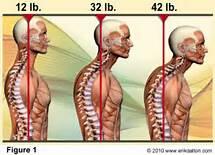
5 minute read
Tech Neck
We live in a high-tech society of cell phones, tablets, computers, etc. With all the far-reaching conveniences and entertainment that these devices truly offer us, an increasingly problematic physical inconvenience has begun to arise as a result of the growing use hand-held technology and computers. As we know, these devices are here to stay, so how do we stay ahead of the curve, or more specifically, the reversed curve?
What is Tech Neck?
Advertisement
The basic definition is the name given to neck soreness from endlessly sitting in front of a computer, typing on a laptop or using any handheld technology. The pain is typically in the cervical spine, which is why it’s called “tech neck”, but it is not limited to the neck. Overuse or improper use of technology can cause pain in the upper or mid-thoracic and lumbar spine as well.
Muscular stiffness and pain, even headache, can be caused by extended periods of time spent looking at a screen or down at devices such as tablets, hand-held gaming systems or smart phones.

While shoulder and neck pain are going to be the most common symptoms of Tech Neck, it can also result in headaches, worsened when the head is bent down towards a computer or smartphone, and other signs of discomfort, like numbness and tingling in the arms, hands, or fingers. However, if left undetected or uncorrected, Tech Neck can even result in deviations to the thoracic and lumbar spine.
The vertebrae in the spine typically act like stacked building blocks and will compensate for misalignments. As with a stack of building blocks, if one block is slightly to the left, the tower will lean to the left unless the block above it compensates by leaning slightly to the right. Our spine works in the much the same way, and so strain on the neck could result in other areas of the spine trying to counterbalance.
What Causes It?
Pause for a moment. Gaze down at your smartphone. Observe what happens to your neck. When you look down, your neck goes into flexion, which means that the normal C-shaped curve reverses, causing pulling in your neck. Your thoracic spine slouches, your shoulders roll forward, and your chin tilts upward into a forward head position. Your head is no longer supported over your body; rather, it is positioned far forward, putting strain on your neck, shoulders, and back. This positioning causes adverse stress on the joints, muscles, and discs if you remain in this position for more than 20 minutes.
This increased pressure in the joints then puts pressure on the nerves, discs and muscles attached to the spine. Tightness in the musculature results in pain and stiffness in the neck, arms, shoulders, and back. Furthermore, this positioning can lead to nerve pressure contributing to common symptoms like headaches, numbing and tingling in the hands and fingers, vertigo, and unexplained nausea.

Normally, when the ears are aligned over the center of your shoulders, the average head exerts 1 0-1 5 pounds of pressure on the neck; about the weight of a bowling ball. Imagine if your head moves forward over the center of your shoulders even by 1 inch. This 1 inch of forward head posturing can increase the weight of the head by as much as six times.
The Future of Neck Problems
In the United States alone, the average person checks their phone almost 50 times a day and spends almost 5 hours on their cell phone. The typical teenager will spend an average of 5,000 hours per year
texting with their neck at an uncomfortable angle. These numbers are alarming when you consider this equates to about 50 pounds of excess pressure put on the cervical spine during every minute spent looking down at a smartphone or other hand-held technology.
In kids who have spines that are still growing and not developed, the real concern is the question of what this may mean for the future health of kids who are using phones all day every day for hours at a time?
Actionable Suggestions
1. Be aware –Try to spend an equal amount of time with your neck back and facing up to counter-balance the amount of time spent with your neck flexed forward
2. Set Time Limits –take a 3- minute break for every 1 5-20 minutes you use your device
3. Set Automatic Reminders –most smart devices have timers take a time-out regularly
4. Use a Tablet Holder –purchase any tablet or iPad holder available at Amazon or other retailers to elevate your device and significantly reduce the amount of neck flexion and forward positioning to keep the device as close to eye level as possible
5. Take Action –pain is our body’s warning system that something isn’t right; don’t ignore it

The Chiropractic Factor
Chiropractic care has been clinically proven to effectively prevent conditions like tech neck, as well as other painful conditions that impact the neck, spine and back. ‘Tech Neck’ is considered a physical trauma to the body, allowing for straightening or reversal of the normal curvature of the neck. The chiropractic adjustment seeks to realign the spine while also stimulating the release of natural pain-relieving chemicals in the body!
If you or your children are suffering from any of the common symptoms of Tech Neck, be sure to schedule a detailed chiropractic spinal evaluation. Early detection of changes to the normal curves of the spine allows for the best opportunity at successful prevention or correction of structural changes due to ‘Tech Neck’.
Article by Dr. Jeannique Norbert

Dr. Norbert is a chiropractor and owner of Empower Family Chiropractic in Lakeway, TX. As a Family Wellness Chiropractor she incorporates suggestions to increase family's health through wellness,
51 2.956.6370 | info@empowerfamilychiro.com | www.empowerfamilychiro.com








